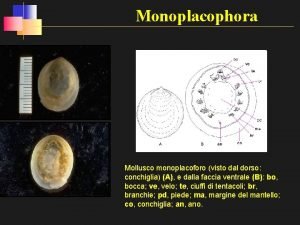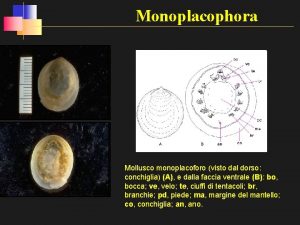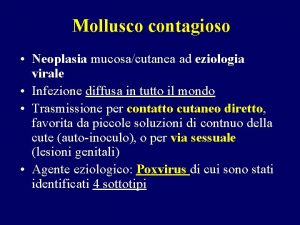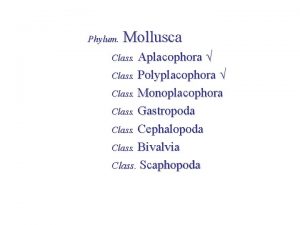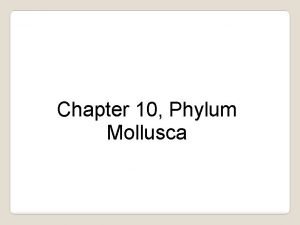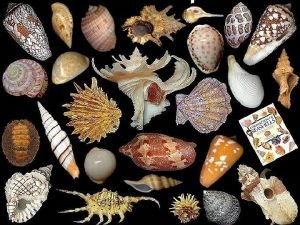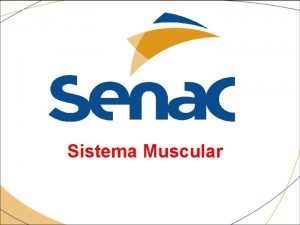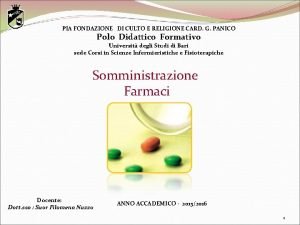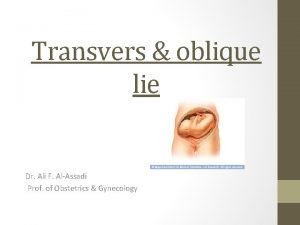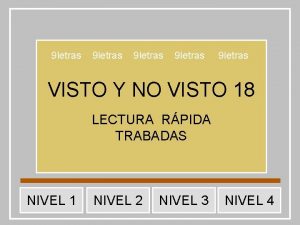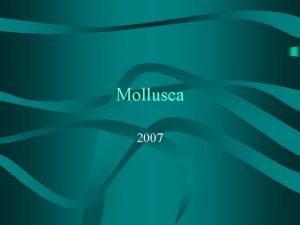Monoplacophora Mollusco monoplacoforo visto dal dorso conchiglia A


















- Slides: 18

Monoplacophora Mollusco monoplacoforo (visto dal dorso: conchiglia) (A), e dalla faccia ventrale (B): bo, bocca; ve, velo; te, ciuffi di tentacoli; br, branchie; pd, piede; ma, margine del mantello; co, conchiglia; an, ano.


ENRICO SCHWABE Zootaxa 186 A summary of reports of abyssal and hadal and Polyplacop Generic distribution of abyssal and hadal Monoplac

"Monoplacophora" is a polyphyletic grade rather than a natural group. Neopilina represents only a single order and family of this once diverse group Knight & Yochelson (1960) review all known forms, and have two or three orders and 5 or 6 families. probematic groups: Bellerophontids, Helcionelloida, "Quasirostroconchs". It is likely that the "Monoplacophora" were quite diverse at high-level taxa, even if much less diverse at the level of species Knight, JB & EL Yochelson (1960), Monoplacophora, in RC Moore (ed. ), Treatise on Invertebrate Paleontology. Part I. Mollusca. Geol. Soc. Amer. and Kansas Univ. Press, 1: 77 -84.

lidium reticulatum, a typical Early Palaeozoic shallow-water Tryblidiid; length about 3. 5 cm Silurian (Wenlock Age) of Baltica (Gotland) "Monoplacophora" - Tryblidiidae Neopilina galatheae, ventral view, showing mouth (at top), multiple gills and mantle, foot (center) and shell (outer ring)

• ? Archinacella arca aff. Wahlman, 1992 Archinacelliopsis patelliformis Hall, 1842

Nerida G. Wilson, Danwei Huang, Miriam C. Goldstein, Harim Cha, Gonzalo Giribet and Greg W. Rouse 2009 Field collection of Laevipilina hyalina Mc. Lean, 1979 from southern California, the most accessible living monoplacophoran J. Mollus. Stud. 2009 75: 195 -197; doi: 10. 1093/mollus/eyp 013. Figure 2. Living specimens of Laevipilina hyalina. A. Artificially arranged group of four individuals on nodule surface. B. Ventral side of female; arrows indicate radula, oocytes and ctenidia.




Now that more material has accumulated, a general review of the metameric structure of these animals seems useful. The new material leaves no doubt about the presence of metamerism in the sense that some organs are repeated following a common rhythm. This has to be accepted as a fact, and is essential for the characterization of recent Monoplacophora. Its theoretical interpretation - whether the metamerism here is related to the metamerism of articulates or not - is of course still open to discussion but, I hope, on a more stable basis. WINGSTRAND, KARL GEORG: On the anatomy and relationships of recent Monoplacophora. Galathea 2 - Report 16: 7 -94

The single unique defining characteristic (or synapomorphy) of the gastropods is a process known as torsion. Even though not all gastropods are torted, those that are not have evolved from torted ancestors. During the development of the planktonic larva, the visceral mass is horizontally twisted nearly 180° in a counterclockwise direction in relation to the lower part of the body. As a result, the mantle cavity, gills, anus, and two nephridopores are rotated from back to front, and are now located in the anterior position, above the head, and the body was no longer symmetrical.

Gastropoda: la torsione dei visceri

It is not quite clear why this first happened, more than five hundred million years ago. Walter Garstang in the 1920 s proposed that it helps larval veliger pull its head inside its shell (and even wrote this as a poem: "Ballad of the Veliger or how the Gastropod got its Twist"!).

"Ballad of the Veliger or how the Gastropod got its Twist"! (Walter Garstang, 1920) The Veliger's a lively tar, the liveliest afloat, A whirling wheel on either side propels his little boat; But when the danger signal warns his bustling submarine, He stops the engine, shuts the port, and drops below unseen. He's witnessed several changes in pelagic motor-craft; The first he sailed was just a tub, with a tiny cabin aft. An Archi-mollusk fashioned it, according to his kind He'd always stowed his gills and things in a mantle-sac behind. Young Archi-mollusks went to sea with nothing but a velum A sort of autocycling hoop, instead of pram - to wheel 'em; And, spinning round, they one by one acquired parental features, A shell above, a foot below - the queerest little creatures. But when by chance they brushed against their neighbours in the briny, Coelenterates with stinging threads and Arthropods so spiny, By one weak spot betrayed, alas, they fell an easy prey Their soft preoral lobes in front could not be tucked away! Their feet, you see, amidships, next the cuddy-hole abaft, Drew in at once, and left their heads exposed to every shaft. So Archi-mollusks dwindled, and the race was sinking fast, When by the merest accident salvation came at last. A fleet of fry turned out one day, eventful in the sequel, Whose head-and-foot retractors on the two sides were unequal: Their starboard halliards fixed astern ran only to the head, While those aport were set abeam and served the foot instead. Predaceous foes, still drifting by in numbers unabated, Were baffled now by tactics which their dining plans frustrated. Their prey upon alarm collapsed, but promptly turned about, With tender morsel safe within and the horny foot without!

Torsion is believed to be driven by an evolutionary adaptation that permitted the mollusc to more efficiently pull into its shell for protection. Opisthobranchs cannot fully withdraw into their shell. They tend to lose full torsion, wherein the body plan reverts to the earlier bilateral symmetry characteristic of Neopilina galathea.

Other explanations are that it helps the adult carry weight of shell, or it was an adult adaptation to protect the head and utilize the anterior water current.

Torsion obviously has benefits (including increased water current and allowing the animal to withdraw more deeply into the shell then would otherwise be possible), but it created a number of problems as well, the most serious of which was fouling. With the anus and nephridia in the front of the body, the animal would be dumping its waste on its head. This problem was solved by slit or cleft in the front of the shell, above the mantle cavity. pre-torted protogastropods already had a slit in their shell. This faced backwards in the pretorted mollusk, so when the entire shell was rotated through 180° it was at the front, and there was a ready-made solution (a perfect example of pre-adaptation). Thus the inhalant current continued to come in over the head and gills, but instead of making a U-turn and passing out the same way, it flowed up and out through the slit in the shell, taking the waste with it. Note that torsion does not imply coiling. The first gastropods evolved from untorted ancestors like Crytolites that still had a coiled shell.
 Mollusco dalla conchiglia allungata
Mollusco dalla conchiglia allungata Monoplacoforo
Monoplacoforo Adulteration of dal with kesari dal mainly causes
Adulteration of dal with kesari dal mainly causes Mollusco contagioso istologia
Mollusco contagioso istologia Sospensivori
Sospensivori Characteristics of class polyplacophora
Characteristics of class polyplacophora Class monoplacophora
Class monoplacophora Class gastropoda
Class gastropoda Phylum mollusca
Phylum mollusca Conchiglia movimento d'amore san juan diego
Conchiglia movimento d'amore san juan diego Conchiglia veggente
Conchiglia veggente Conchiglia movimento d'amore san juan diego
Conchiglia movimento d'amore san juan diego Lesioni dorso lombari
Lesioni dorso lombari Dorso epitrochlearis mink
Dorso epitrochlearis mink Injeção intramuscular gluteo
Injeção intramuscular gluteo Ventrogluteale intramuscolo
Ventrogluteale intramuscolo Gesso antibrachio metacarpale
Gesso antibrachio metacarpale Manual plasenta
Manual plasenta Oblique lie
Oblique lie
